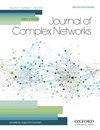A fast parameter estimator for large complex networks
IF 1.5
4区 数学
Q2 MATHEMATICS, INTERDISCIPLINARY APPLICATIONS
引用次数: 3
Abstract
Math anxiety is a clinical pathology impairing cognitive processing in math-related contexts. Originally thought to affect only inexperienced, low-achieving students, recent investigations show how math anxiety is vastly diffused even among high-performing learners. This review of data-informed studies outlines math anxiety as a complex system that: (i) cripples well-being, self-confidence and information processing on both conscious and subconscious levels, (ii) can be transmitted by social interactions, like a pathogen, and worsened by distorted perceptions, (iii) affects roughly 20$\%$ of students in 63 out of 64 worldwide educational systems but correlates weakly with academic performance and (iv) poses a concrete threat to students’ well-being, computational literacy and career prospects in science. These patterns underline the crucial need to go beyond performance for estimating math anxiety. Recent advances in network psychometrics and cognitive network science provide ideal frameworks for detecting, interpreting and intervening upon such clinical condition. Merging education research, psychology and data science, the approaches reviewed here reconstruct psychological constructs as complex systems, represented either as multivariate correlation models (e.g. graph exploratory analysis) or as cognitive networks of semantic/emotional associations (e.g. free association networks or forma mentis networks). Not only can these interconnected networks detect otherwise hidden levels of math anxiety but—more crucially—they can unveil the specific layout of interacting factors, for example, key sources and targets, behind math anxiety in a given cohort. As discussed here, these network approaches open concrete ways for unveiling students’ perceptions, emotions and mental well-being, and can enable future powerful data-informed interventions untangling math anxiety.大型复杂网络的快速参数估计器
数学焦虑是一种损害数学相关认知过程的临床病理。最初人们认为数学焦虑只会影响没有经验、成绩不佳的学生,但最近的调查显示,即使在成绩优异的学生中,数学焦虑也广泛存在。这篇基于数据的研究综述概述了数学焦虑是一个复杂的系统,它:(i)在意识和潜意识层面削弱幸福感、自信心和信息处理;(ii)可以像病原体一样通过社会互动传播,并因扭曲的观念而恶化;(iii)在全球64个教育体系中的63个体系中,影响了大约20%的学生,但与学习成绩的相关性较弱;(iv)对学生的福祉、计算素养和科学领域的职业前景构成具体威胁。这些模式强调了评估数学焦虑的关键需要超越成绩。网络心理测量学和认知网络科学的最新进展为检测、解释和干预这种临床状况提供了理想的框架。结合教育研究、心理学和数据科学,本文回顾的方法将心理结构重构为复杂的系统,以多变量相关模型(如图探索性分析)或语义/情感关联的认知网络(如自由关联网络或forma mentis网络)表示。这些相互联系的网络不仅可以检测到隐藏的数学焦虑水平,更重要的是,它们可以揭示相互作用因素的具体布局,例如,特定人群中数学焦虑背后的关键来源和目标。正如本文所讨论的,这些网络方法为揭示学生的感知、情绪和心理健康开辟了具体的途径,并可以使未来强大的数据知情干预措施解开数学焦虑。
本文章由计算机程序翻译,如有差异,请以英文原文为准。
求助全文
约1分钟内获得全文
求助全文
来源期刊

Journal of complex networks
MATHEMATICS, INTERDISCIPLINARY APPLICATIONS-
CiteScore
4.20
自引率
9.50%
发文量
40
期刊介绍:
Journal of Complex Networks publishes original articles and reviews with a significant contribution to the analysis and understanding of complex networks and its applications in diverse fields. Complex networks are loosely defined as networks with nontrivial topology and dynamics, which appear as the skeletons of complex systems in the real-world. The journal covers everything from the basic mathematical, physical and computational principles needed for studying complex networks to their applications leading to predictive models in molecular, biological, ecological, informational, engineering, social, technological and other systems. It includes, but is not limited to, the following topics: - Mathematical and numerical analysis of networks - Network theory and computer sciences - Structural analysis of networks - Dynamics on networks - Physical models on networks - Networks and epidemiology - Social, socio-economic and political networks - Ecological networks - Technological and infrastructural networks - Brain and tissue networks - Biological and molecular networks - Spatial networks - Techno-social networks i.e. online social networks, social networking sites, social media - Other applications of networks - Evolving networks - Multilayer networks - Game theory on networks - Biomedicine related networks - Animal social networks - Climate networks - Cognitive, language and informational network
 求助内容:
求助内容: 应助结果提醒方式:
应助结果提醒方式:


